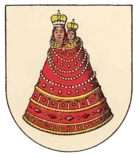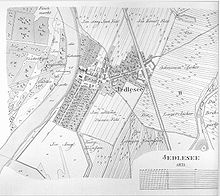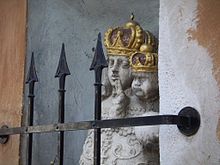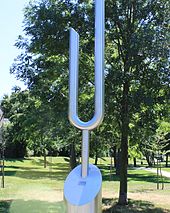Every lake
| Every lake | |
|---|---|
| coat of arms | map |
 |

|
Jedlesee was an independent municipality until 1894 and has been a district of Vienna in the 21st Viennese district of Floridsdorf since 1905 as well as one of the 89 Viennese cadastral communities .
geography
Jedlesee is part of Vienna's 21st district, Floridsdorf , which until 1904 belonged to Lower Austria. From the time of incorporation, an ever faster development from agricultural villages to suburban settlement areas began.
The old village of Jedlesee (also: Jedlersee) was at the southwest end of the Marchfeld . It was created on a branch of the Danube , the "Black Lacquer", which is still recognizable today as a strip of meadow next to the church. This branch of the Danube was often one of the reasons for the destruction of Jedlesee by the flooding Danube and ice rushes. With the regulation of the Danube , the "black paint" was separated from the main stream and after the Second World War it was completely filled with the rubble from the bombed Vienna houses and various industrial and petroleum waste until the 1970s.
The Schwarze Lackenau, north of the old arm of the Danube, which has moved closer to Vienna as a result, forms its own cadastral community, which is now regarded as part of the Jedlesee district. The cadastral communities Jedlesee (144.97 hectares ) and Schwarze Lackenau (518.62 hectares) together cover an area of 663.59 hectares. 85.97 hectares of Schwarzen Lackenau are in the area of the municipality of Döbling , 30 hectares in the area of the municipality of Brigittenau . These proportions, however, are bodies of water in the Danube. Sections of the Danube Island and the Marchfeld Canal also belong to the Schwarzen Lackenau .
Under the slightly modified name of Schwarzlackenau there is a three- counting district of the official statistics, the borderline of which, however, is not identical to that of the cadastral community. This also applies to the statistical census district Alt-Jedlesee, which consists of five census districts, and the statistical census district Neu-Jedlesee, which consists of four census districts .
Jedlesee borders in the north on the Lower Austrian communities Klosterneuburg and Langenzersdorf as well as on the Floridsdorf district of Strebersdorf . In the east lie the Floridsdorf districts Großjedlersdorf and Floridsdorf . In the southeast, Jedlesee borders - in the direction of the Danube - on the Döblingen districts of Kahlenbergerdorf and Nussdorf and on the Brigittenau.
history
The village of Jedlesee was created at the landing site of the transfer from Marchfeld to Nußdorf , probably as a Franconian re-establishment after Otto I's victory over the Magyars on the Lechfeld . Already on July 5, 1014, the place "Uotcinessevve" is mentioned in a deed of donation from the Diocese of Passau , which is attributed to Jedlesee. The German Emperor Heinrich II donated this area to the episcopal church in Passau, along with properties in Herzogenburg , Krems an der Donau and Tulln for the construction of churches.
Jedlesee was originally a farming and fishing village in the floodplain of the Danube. Numerous branches of the Danube were located in today's settlement area - on the western edge of the village the "Schwarze Lacke", which turned into a raging branch of the river during floods. Despite frequent devastation by floods and ice rushes as well as the armies that passed through on the march to Vienna, the place was rebuilt again and again. The floods were only ended by the regulation of the Danube (1870–75). Jedlesee gained in importance through the establishment of a ferry crossing the Danube. The Überfuhrstraße still reminds of this today.
From 1778 on, Maria Theresa's personal physician , Anton Freiherr von Störck , owned the Jedlesee estate; under him, not only was the Loretto Chapel redesigned into a parish church in 1779 and his own school built in 1782, but in 1787 he also built a brewery (formerly Gambrinus) at the fork in Prager Strasse-Hopfengasse. Jedlesee got a closer connection to the trade route to Bohemia via Hopfengasse.
The Aupark Jedlesee is one of the last natural green oases in Floridsdorf after the Danube regulation. The O'Brien memorial at the north entrance of the Aupark commemorates Major General Johann Freiherr von O'Brien , who in 1809 was able to force the French to retreat with only a few Austrian soldiers and thus an important prerequisite for Archduke Karl's victory in the Battle of Aspern reached.
Jedlesee is connected to the Donauinsel recreation area by a suspension bridge ( Jedleseer Brücke ) in the extension of the overpass road. The Aupark Jedlesee is connected to the New Danube by green bridges over the Danube bank motorway (A22) . Beethoven enjoyed the walks through the alluvial forest, they were a welcome change from city life in Vienna for him. The reason for his frequent visits to Jedlesee was Countess Erdödy , whose small country house is now known as the “Beethovenschlössl”.
A law enacted on May 8, 1894 Jedlesee was with until 1881 to Leopoldau belonging Donaufeld , and with Floridsdorf and New Jedlersdorf for greater community Floridsdorf together, which was incorporated in 1904 to Vienna.
coat of arms
The Jedleseer coat of arms shows the Virgin Mary at Loretto, holding the baby Jesus in her arms. The Virgin Mary shines completely in gold with the baby Jesus in the middle of the silver heraldic shield. The miraculous image shows the two wrapped in a golden cloak, decorated with strings of pearls and crowns. On the side there are two letters in red: M (for Maria) and L (for Loretto). Maria zu Loretto is the patroness of the Jedleseer Church, the coat of arms is a replica of the pilgrimage statue there. Maria zu Loretto can be seen as a statue at the central intersection of Anton-Bosch-Gasse and Wiener- / Michtner Gasse.
Air traffic in Jedlesee
The "Österreichische Luftverkehrs AG" (ÖLAG) , founded on May 3, 1923, took up its regular service on May 14 with a flight from Munich to Vienna ( Junkers F 13 , registration D-219, pilot was Hans Baur von Junkers) and landed the After a flight time of 1:45 hours, the machine was not at Aspern Airport , but on the floodplain in Jedlesee. 49% of the ÖLAG owned the Junkers aircraft works, which brought in the aircraft according to the order and which belonged to their "Trans-Europa-Union". Of course, sightseeing flights were also carried out again and again. The ÖLAG worked with the Münchner Rumpler Luftverkehr , the Swiss Ad Astra Aero and the Hungarian Aero-Express.
Most of the lines were served by the F 13, the first real airliner. While the Munich-Vienna-Munich route was operated by wheeled undercarriages from May 23, 1923, from July 16, 1923, at 12:30 p.m., the extended land and sea airfield Vienna-Jedlesee was followed by F-13 planes on floats Budapest, which had their landing stage on the Danube. In return, Budapest started at 10 a.m. In the 1923 season, the route was flown daily, except Sunday, until September 30th. The 218 km long route took around 1:45 hours. The average occupancy was 50% of the seat capacity. Since the expansion of the ÖLAG airfield Vienna-Jedlesee was not economically viable, the ÖLAG finally relocated its land planes to Vienna-Aspern in May 1924, and the building was also transferred to Vienna-Aspern.
Residential buildings and settlements
The Karl-Seitz-Hof, sometimes perceived as part of Jedlesee (unofficially called Gartenstadt Jedlesee before it was named), is actually already in the KG Großjedlersdorf II (also called Neujedlersdorf ); the border is the Voltagasse, which runs directly to the north.
Attractions
Erdődy estate
Ludwig van Beethoven repeatedly stayed as a guest in the Erdődy estate built in 1795 , the country house of the Counts Peter and Anna-Maria Erdődy in what was then Augasse (now Jeneweingasse) . Beethoven's multiple stays at the invitation of the Countess are guaranteed in particular for 1815/16; also the organization of house music evenings under Beethoven's direction. It was thanks to the art-loving Countess that aristocratic patrons provided Beethoven with the financial means that enabled him to find his adopted home in Vienna.
The friendship between Beethoven and Countess Erdödy was also expressed in the composer's work: the composer dedicated several works to Anna Maria Erdödy, including the two piano trios Opus 70 (1808), the sonatas for violoncello and piano Opus 102 (1817) and the canon Glück, Glück zum Neujahr WoO 176 (1819).
Part of the estate burned down in 1863, but the lower part with the old staircase was preserved. A memorial plaque shows the water level of the great Danube flood in 1830. On the far right there is a statue of Florian in a helmet, armor and sagum, in the left arm a flag, with the right extinguishing the flames that are beating out the windows of a house. In the garden there is a statue of St. John of Nepomuk , which was recreated by the sculptor Würtinger based on the original that was destroyed in the Second World War.
Since 1973 the estate has been a cultural center on the initiative of the "Association of Friends of the Beethoven Memorial in Floridsdorf" founded by Leopold Wech, where chamber music, domestic and folk music were cultivated and authors' evenings and lectures were held. The memorial had to close in 2013 due to a change of ownership. A cooperation with the Floridsdorf District Museum has made it possible for the association's events to be held there since then and for the memorial's exhibits to continue to be accessible to the public.
Beethovenweg
Ludwig van Beethoven, who regularly left the city of Vienna at the beginning of the 19th century and spent the warm summer days in the city's suburbs, had found various homes in Nussdorf and Grinzing . Through his acquaintance with Countess Erdödy he received the invitation to come to her newly acquired "Landgut zu Jedlersee". Beethoven did not want to take the long detour from Nussdorf over the Danube bridge over the Prater and decided on the shortest route, the crossing between Jedlesee and Nussdorf.
In memory of Beethoven's walks in Jedlesee, the “Beethovenweg” was opened on May 12, 2007. Along the way, four meter high sculptures designed by the artist Manfred Satke and produced by Josef Frantsits were erected, which have the shape of broken tuning forks (indication of Beethoven's hearing loss).
The stations of the Beethovenweg:
- District Museum Floridsdorf
- Karl-Seitz-Hof
- Beethoven memorial
- Maria Loretto Church
- O'Brien memorial
- Danube Island cherry grove
Maria-Theresien-Schlössl
The front building of the Jedleseer mansion was destroyed in 1683 during the second Turkish siege of Vienna . From 1778 to 1789 the mansion belonged to the doctor Freiherr Anton von Störck , who was Maria Theresa of Austria's personal doctor . After the Second World War, the Maria-Theresien-Schlössl served as substitute accommodation for the rectory of the Maria-Loretto-Church , which had been destroyed by bombs , and was then used by a tennis club until 2003. The building is currently being restored. Use by the parish Jedlesee is planned.
Danube Island cherry grove
The cherry grove was designed in spring 2002 by the Japanese artist group “to the woods” in collaboration with the City of Vienna's Forestry Office. The cherry trees are part of the 1000 Japanese cherry trees that were given as a gift to the city of Vienna on the occasion of Austria's 1000th anniversary.
Parishes and cemeteries
Church of the Holy Blood of Christ
→ Main article: Parish Church Gartenstadt
The Jedleseer parade ground and the military barracks camp were no longer used after the First World War . On this area, Prelate Josef Gorbach built an emergency church (then Moltkegasse, now Dunantgasse 4-6) in one of the vacant properties - as part of a program that encompassed several Vienna districts (1935/36), and he took care of it himself. After war damage, the emergency church was renovated in 1947–49, but replaced in 1962–64 by a new building built elsewhere according to plans by the German architect and town planner Alfons Leitl (parish station with church "Hl. Blut Christi", later parish church Gartenstadt).
Parish Church of Maria Loretto
→ Main article: Parish church Jedlesee
Already in the 11th century there was a small one, dedicated to St. Chapel consecrated to Nicholas, later followed by other chapels; they were dedicated to St. Sebastian, St. John of Nepomuk and St. consecrated three kings.
Church of St. Anthony of Padua
→ Main article: Parish church Schwarzlackenau
The building, also known as St. Anthony of Padua Church , was built in 1937 as a wooden barrack.
Every graveyard
→ Main article: Jedleseer Friedhof
The Jedleseer Friedhof is located at Audorfgasse 47 and houses 8,448 grave sites on an area of around 55,994 m². It was laid out in 1873 and is now managed by cemetery master Karl Rzihauschek on behalf of Friedhöfe Wien GmbH .
Sports
literature
- Felix Czeike: Vienna XXI. Floridsdorf. Viennese district leader . J&V, Vienna 1979, ISBN 3-7141-6221-6 .
- Raimund Hinkel: Vienna XXI. Floridsdorf. The home book. Jedlesee, Schwarzlackenau, Strebersdorf, Jedlersdorf, Leopoldau, Stammersdorf, intermediate bridges, Donaufeld, Floridsdorf, Jedlersdorf am Spitz . Brandstätter, Vienna 1994. ISBN 3-85447-528-4 .
Web links
Individual evidence
- ^ Topographical Post-Lexicon of the Crown Land of Austria under the Enns . Imperial and Royal Court and State Printing House, Vienna 1851 ( Topographical Post Lexicon in the Google Book Search).
- ^ Georg Scheibelreiter: The Babenberger . Böhlau, 2010, ISBN 978-3-205-78573-6 ( limited preview in Google book search).
- ↑ [1] Flood disasters in Vienna 1200-1500
- ↑ [2] History of the Jedlesee district
- ↑ [3] ( page no longer available , search in web archives ) Info: The link was automatically marked as defective. Please check the link according to the instructions and then remove this notice. Beethoven's friendship with Anna Maria von Erdödy.
- ^ Jedlesee in the Vienna History Wiki of the City of Vienna and Donaufeld in the Vienna History Wiki of the City of Vienna
- ^ [4] History of the Jedlesee district
- ↑ http://vivent.at/ehemalige-wiener-museen/
- ↑ The route of the Beethovenweg ( page no longer available , search in web archives ) Info: The link was automatically marked as defective. Please check the link according to the instructions and then remove this notice. PDF 502KB
- ↑ The Schlössl renovation has started. Retrieved November 2, 2016 .
- ↑ Loretto Schlössl new shine, new purpose. (No longer available online.) Archived from the original on November 4, 2016 ; accessed on November 2, 2016 . Info: The archive link was inserted automatically and has not yet been checked. Please check the original and archive link according to the instructions and then remove this notice.
- ↑ Online presence of the artist group to the woods Kirschenhain at the Jedleseer Brücke on the Danube Island
- ↑ Online presence of the parish Jedlesee
Coordinates: 48 ° 16 ' N , 16 ° 23' E






